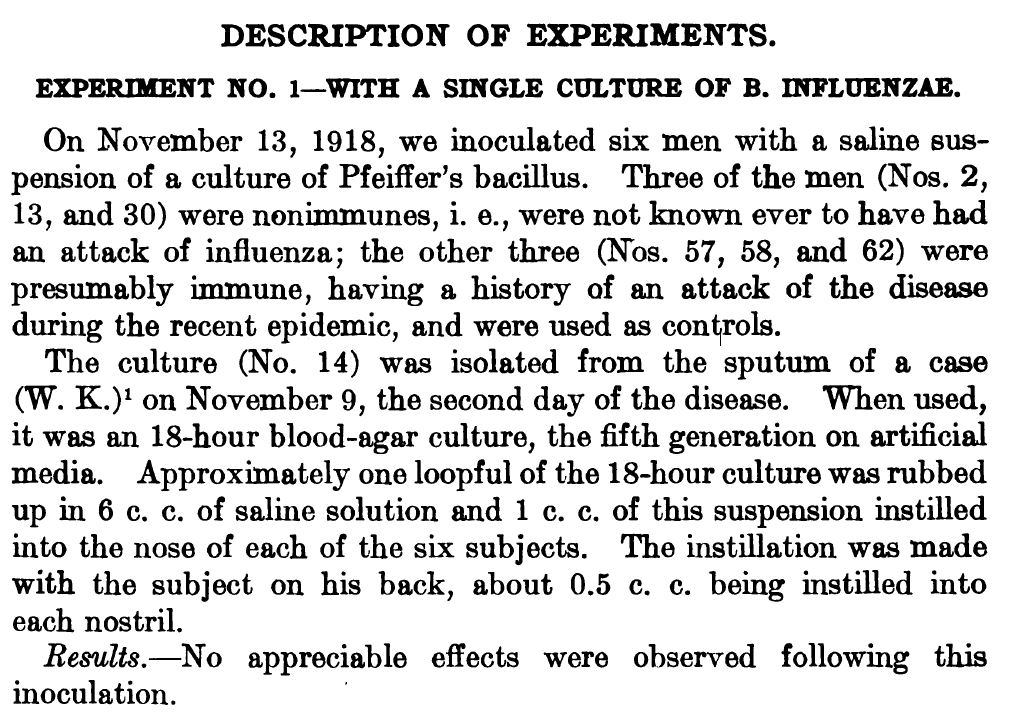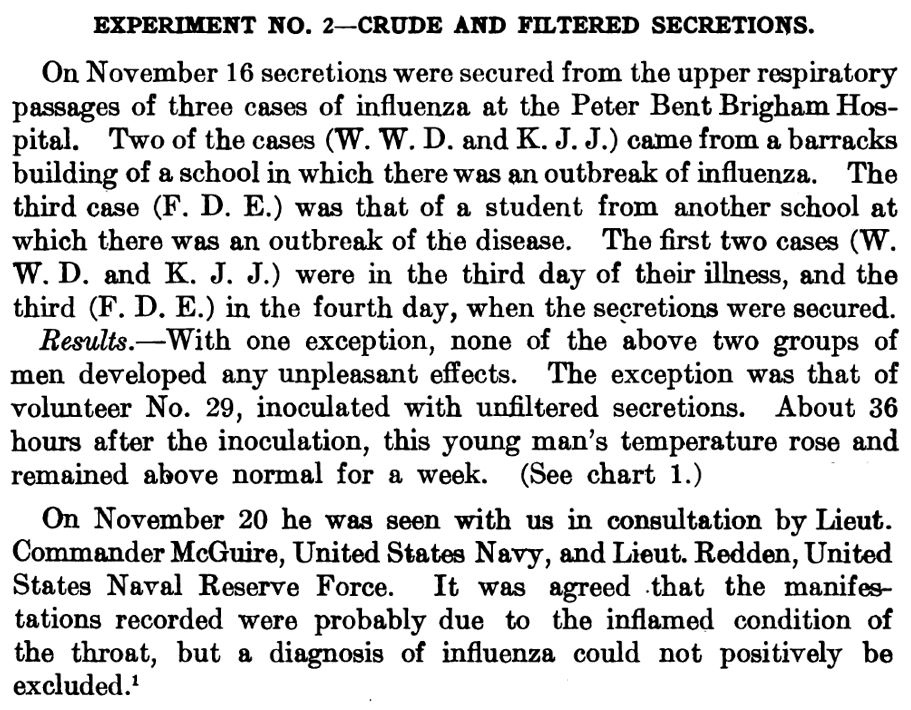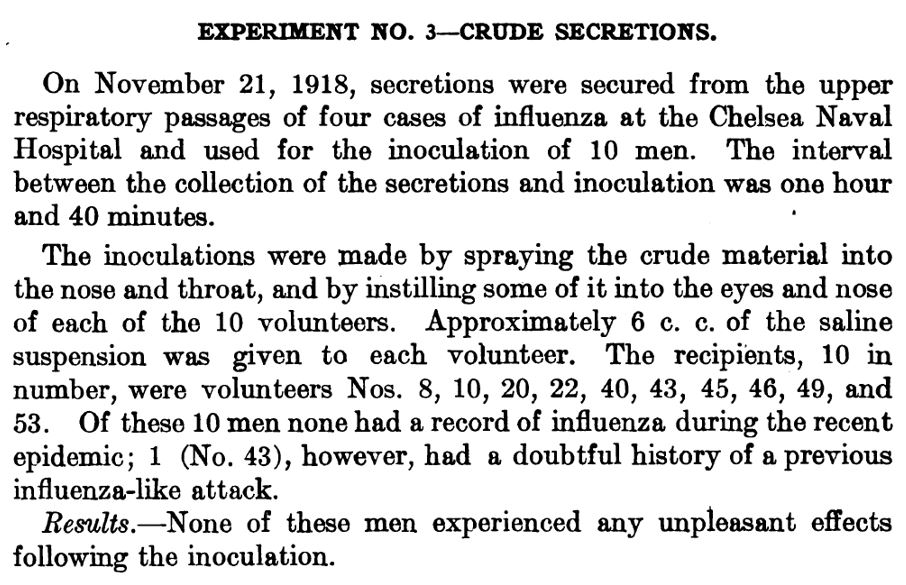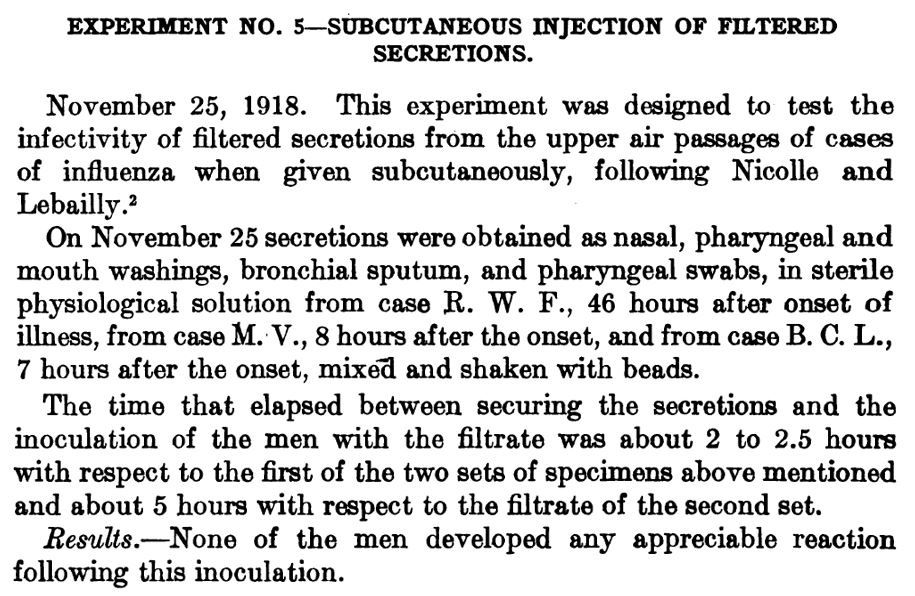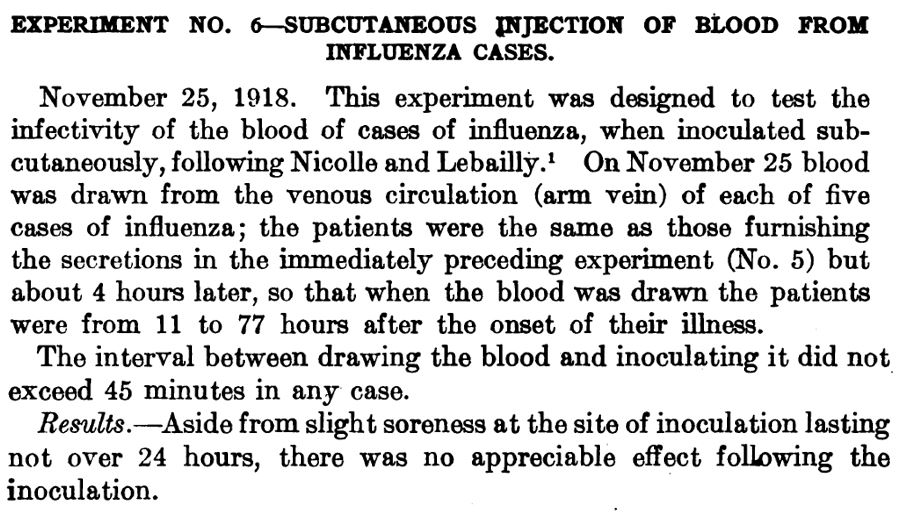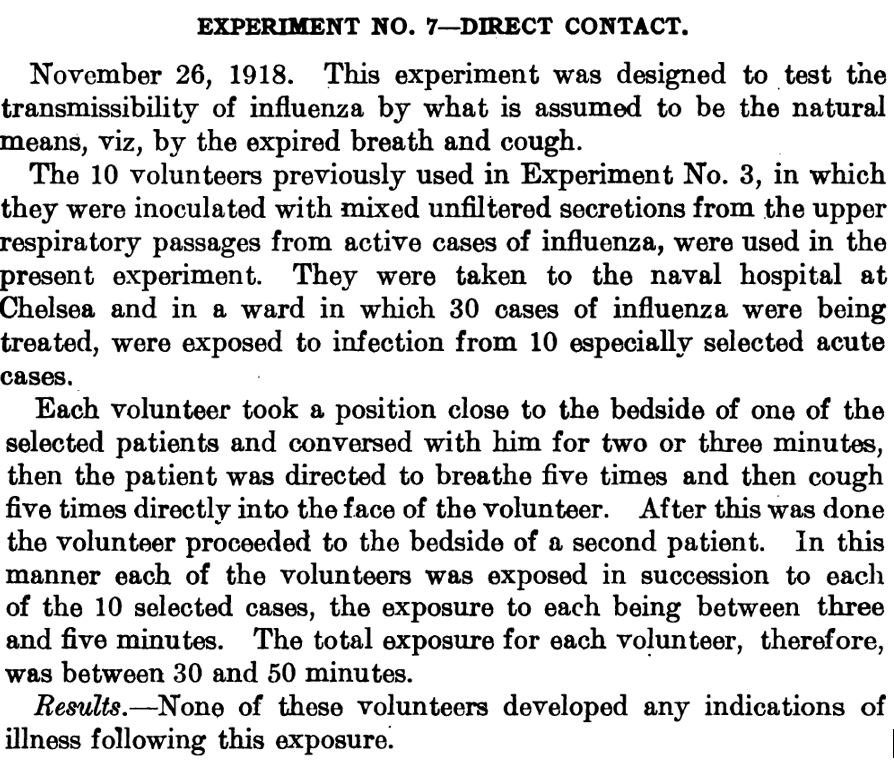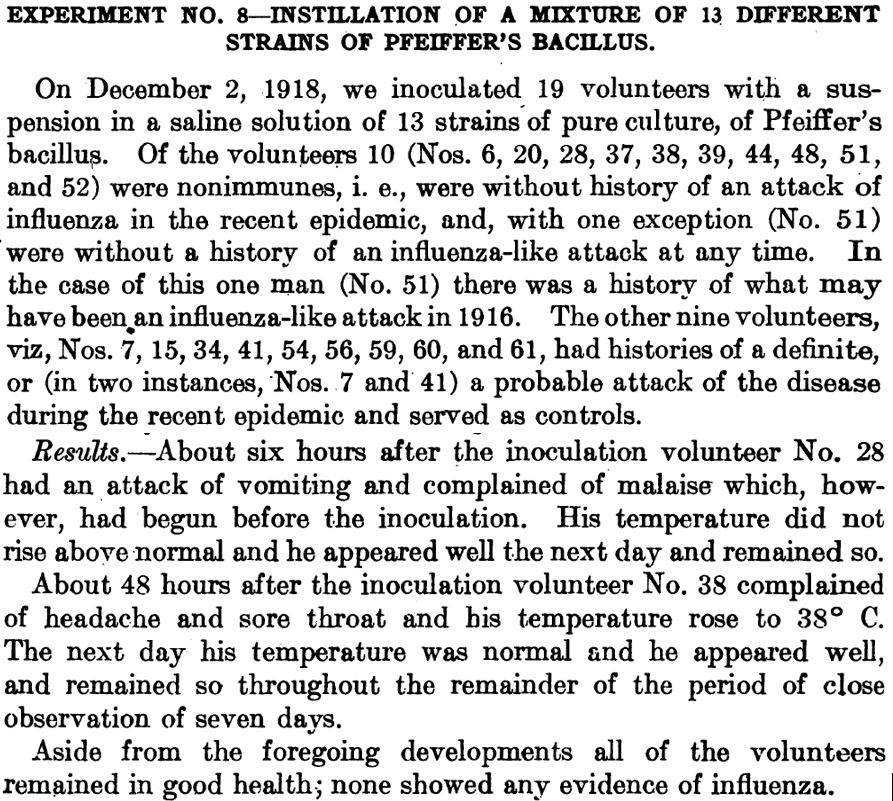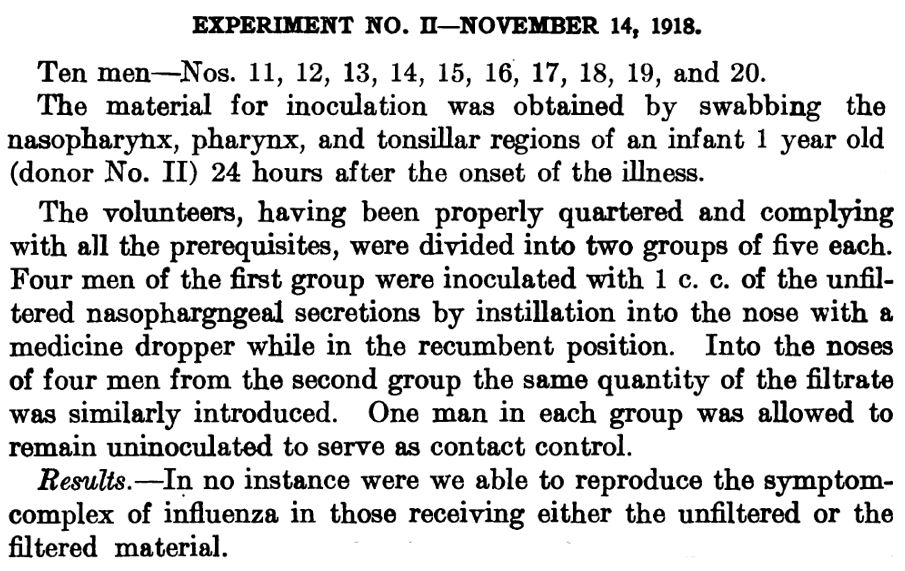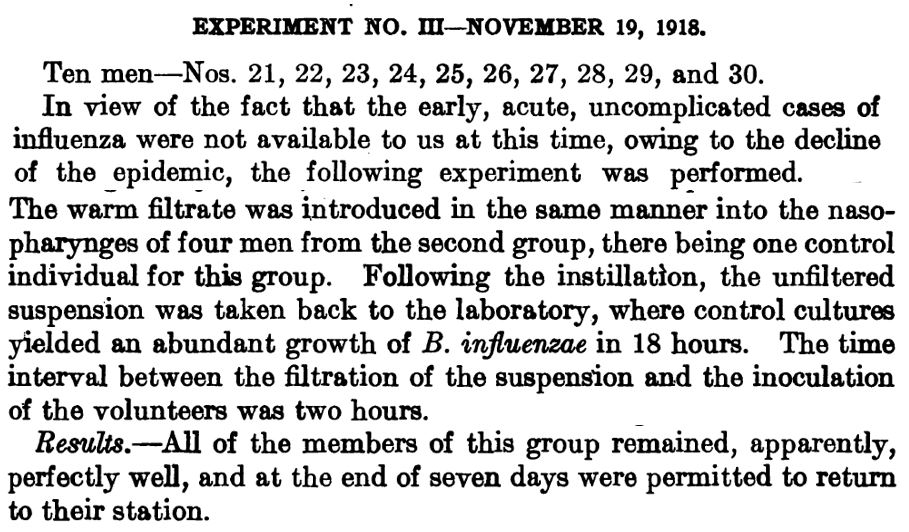Failed Contagion Experiments

All real-life genuinely scientific attempts to “transmit” illnesses such as influenza, colds, measles, chicken pox and the likes have failed or proved inconclusive. This was well known and established in the early 20th century.
However, there was a battle between the germ theorists supported by the money-power to fearmonger and sell serums and injections by developing the pseudoscience of virology (among others), and those who asserted that disease is a complex process and arises from within, with “bacteria” and “viruses” simply being consequential to disease states and not causal.
Sadly, the money-power won, as it always tends to. We present below some of these experiments.
Inability to Transmit Influenza Despite Extensive and Invasive Attempts
This is a US Government publication from February 1921, Bulletin No. 123 by the Hygienic Laboratory and represents studies in which attempts were made to transmit influenza from healthy to sick patients in many different ways.
View PDF File
(109 pages)
It has detailed descriptions of three separate studies:
- Experiments Upon Volunteers To Determine The Cause And Mode Of Spread Of Influenza. Boston, November And December, 1918
- Experiments Upon Volunteers To Determine The Cause And Mode Of Spread Of Influenza. San Francisco , November And December, 1918
- Experiments Upon Volunteers To Determine The Cause And Mode Of Spread Of Influenza. Boston, February And March, 1919
The following is just a small selection of from the vast range of experiments peformed:
See also:
View PDF File
(14 pages)
Inability to Transmit the Common Cold
View PDF File
(7 pages)
In this series of experiments, nasal secretions were secured persons suflfering with acute uncomplicated coryza. After being and passed through a Berkefeld filter, these secretions were sprayed the nasal mucosa of 100 volunteers. The experiments presented no convincing evidence indicative of a filter passing organism as the exciting factor in acute coryza.
See also: Review of Literature on Flu and Common Cold, 1924
Inability to Transmit Measles Through Inoculation
Need of Further Research on the Transmissibility of Measles and Varicella—Alfred F. Hess, JAMA, October 18, 1919
To the Editor: —I have just read the abstract in The Journal (Oct. 4, 1919, p. 1086) of Sellards' article on "The Insusceptibility of Man to Inoculation with Blood from Measles Patients" (Bull. Johns Hopkins Hosp. 30:257 [Sept.] 1919).
It is remarkable that Sellards was unable to produce this highly infectious disease by means of the blood or the nasal secretion of infected individuals. Not long ago, however, I had a similar experience with varicella (Am. J. Dis. Child. 16:34 [July] 1918).
Thus we are confronted with two diseases—the two most infectious of the endemic diseases in this part of the world—which we are unable to transmit artificially from man to man.
The result was most surprising in regard to chickenpox, and if the same rule holds good for measles it would seem as if a basic principle must be involved.
Evidently in our experiments we do not, as we believe, pursue nature's mode of transmission; either we fail to carry over the virus, or the path of infection is quite different from what is commonly thought to be.
Failure to Transmit Typhoid, Diptheria, Pneumonia Through Inoculation of "Germs"
Writing in "The Medical Voodoo", a 1935 book exposing the emerging takeover of medicine by money and pseudoscience, the author mentions:[1]
Numerous experiments are reported in the literature by reliable bacteriologists, wherein the attempt was made to produce disease in healthy persons by feeding them the supposedly causative germs in food and drink; and by swabbing the air passages of their throats and nostrils with the germ culture—and in no single instance did the disease develop.
Dr. John B. Fraser, M.D., of Toronto, reported 45 such experiments with typhoid germs put into water, milk, bread, cheese, meat, fish, headcheese, butter, etc.; 19 experiments with pneumonia germs; a total of 40 experiments with diphtheria germs—which were not only given in food and drink, but millions were swabbed in the nose and throat, and every facility given them to develop; 19 tests with tubercle bacilli, 11 with germs of spinal meningitis, and 10 with mixed germs, but all failed to produce any effect.
Dr. Fraser says: "These tests were made scientifically, and part of the germs were grown from stock-tubes furnished by one of the best known laboratories in North America. These are facts, not opinions."
Dr. Fraser's experience with these tests was repeated in attempts to transmit influenza to healthy and supposedly "non-immune" human subjects at the U. S. Quarantine Station on Gallupa Island near Boston in December 1918.
The subjects of experiment were 68 volunteers from the U. S. Naval Detention Camp on Deer Island, Boston, and the experiments consisted of inoculations with pure cultures of the Pfeiffer bacillus (influenza germ), with secretions from the upper respiratory tract, and with blood from typical cases of influenza.
Thirty men were inoculated by spray, swab, or both, of the nose and throat, and in no instance did influenza develop in any of them—not even when exposed to persons suffering from the disease.
Similar experiments were made with 50 men at Angel Island, San Francisco, the same year; and a report of these experiments was published in Government Bulletins No. 57 and No. 123 by the Navy Department Bureau of Medicine and Surgery, Division of Sanitation.
These experiments, together with the fact that there is no escape from germs, that they are with us always—in us, around us, above and beneath us—should convince any reasoning intelligence that old Pettenkofer was right in saying that germs are not the important factor in disease, that "it is the disposition of the individual that counts."
Similar to the above:
See: Dr. Henry Littlejohn on Contagion: Fear of contagion itself (not mixing with the sick in itself) is what induces illness.
Footnotes
1. Annie Hale, "The Medical Voodoo", New York, 1935, pp. 91-92.

